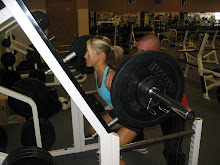
Lack of time is the number one reason people give for not exercising. And lack of results once they do start exercising isn't far behind. Interval training is a great solution for both of these common problems.
Interval training involves alternating short bursts of intense activity with what is called active recovery, which is typically a less-intense form of the original activity.
The Swedes came up with a term for this type of training: fartlek, which means speed play. Not only is it an efficient training method, fartlek training can help you avoid injuries that often accompany non-stop, repetitive activity, and provides the opportunity to increase your intensity without burning yourself out in a matter of minutes.
The Swedes came up with a term for this type of training: fartlek, which means speed play. Not only is it an efficient training method, fartlek training can help you avoid injuries that often accompany non-stop, repetitive activity, and provides the opportunity to increase your intensity without burning yourself out in a matter of minutes.
Unlike traditional interval training, fartlek training does not involve specifically or accurately measured intervals. Instead, intervals are based according to the needs and perceptions of the participant. In other words, how you feel determines the length and speed of each interval.
THE ADVANTAGES OF INTERVALS
Interval training utilizes the body's two energy-producing systems: the aerobic and the anaerobic. The aerobic system is the one that allows you to walk or run for several miles, that uses oxygen to convert carbohydrates from various sources throughout the body into energy.
The anaerobic system, on the other hand, draws energy from carbohydrates (in the form of glycogen) stored in the muscles for short bursts of activity such as sprinting, jumping or lifting heavy objects. This system does not require oxygen, nor does it provide enough energy for more than the briefest of activities. And its byproduct, lactic acid, is responsible for that achy, burning sensation in your muscles that you feel after, say, running up several flights of stairs.
The anaerobic system, on the other hand, draws energy from carbohydrates (in the form of glycogen) stored in the muscles for short bursts of activity such as sprinting, jumping or lifting heavy objects. This system does not require oxygen, nor does it provide enough energy for more than the briefest of activities. And its byproduct, lactic acid, is responsible for that achy, burning sensation in your muscles that you feel after, say, running up several flights of stairs.
INTERVAL BASICS
Interval training allows you to enjoy the benefits of anaerobic activities without having to endure those burning muscles. In its most basic form, interval or fartlek training might involve walking for two minutes, running for two, and alternating this pattern throughout the duration of a workout.
Interval training allows you to enjoy the benefits of anaerobic activities without having to endure those burning muscles. In its most basic form, interval or fartlek training might involve walking for two minutes, running for two, and alternating this pattern throughout the duration of a workout.
The intensity (or lack thereof) of each interval is up to how you feel and what you are trying to achieve. The same is true for the length of each interval. For example, if it is your habit to walk two miles per day in 30 minutes, you can easily increase the intensity of your walk (as well as up its calorie-burning potential) by picking up the pace every few minutes and then returning to your usual speed.
A great trick is to tell yourself that you'll run a particular distance, from the blue car to the green house on the corner, for example, and then walk from the green house to the next telephone pole.
When you first start fartlek training, each interval can be a negotiation with yourself depending on how strong or energetic you happen to feel during that particular workout. This helps to break up the boredom and drudgery that often comes from doing the same thing day after day.
A MORE ADVANCED APPROACH
Despite its simplicity, it also is possible to take a very scientific approach to interval training, timing both the work and recovery intervals according to specific goals. The box lists the four variables to keep in mind when designing an interval training program.
An certified personal trainer can help you design an interval training program based on your particular goals.
An certified personal trainer can help you design an interval training program based on your particular goals.
Consider the following four variables when designing an interval training program:
Intensity (speed) of work interval
Duration (distance or time) of work interval
Duration of rest or recovery interval
Number of repetitions of each interval
*Reprinted with permission from the American Council on Exercise (ACE).
This ACE Fit Fact is taken from ACE FitnessMatters® magazine. Want more information like this delivered directly to your home? ACE FitnessMatters, the bi-monthly magazine from the American Council on Exercise® (ACE®), is the source for the most accurate, up-to-date fitness information you need to live a healthy, active life. Subscribe to ACE FitnessMatters Magazine online or call 1-888-825-3636. The American Council on Exercise does not endorse or promote the companies, products or services that reside on this website. ACE does not receive revenue generated from any organizations that advertise on this Web site. Copyright 2003 American Council on Exercise. All Rights Reserved.



No comments:
Post a Comment